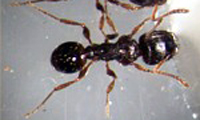|  Pavement
Ants Pavement
Ants
Order: Hymenoptera
Family: Formicidae
Scientific Name: Tetramorium caespitum (Linnaeus)
Color: Dark brown to blackish
Legs: Six
Shape: Segmented; oval; grooves on head and thorax
Size: 1/8"
Antennae: Yes
Flight: No
Pavement ants get their name because they make their nests in or
under cracks in pavement, building dirt mounds on the surface. They
were introduced from Europe by early settlers. They can infest structures.
Pavement ants can be found in All 50 States
Habits
These ants will eat almost anything, including insects, seeds, honeydew,
honey, bread, meats, nuts and cheese. It is not uncommon to find
Pavement ants feeding on dog food or bits of food dropped on the
floor. Colonies can average 3-4,000 ants and numerous queens.
Habitat
These ants live in or under pavement cracks but may also be found
under anything lying on top of the ground. They will also nest in
mulch in landscape beds. They can nest indoors in walls, insulation
or under floors.
Threats
These ants do not pose a public health risk, but they can contaminate
food and should be avoided. Although not aggressive, workers can
bite and sting.
Control
Eliminate standing water. Pests, such as ants, are attracted to
moisture. Keep tree branches and other plants cut back from the
house. Sometimes pests use these branches to get into your home.
Make sure that there are no cracks or little openings around your
house. Sometimes pests use these to get into your home. Make sure
that firewood and building materials are not stored next to your
home. Pests like to build nests in stacks of wood.
Key to control is locating all nests and treating them with a residual
insecticide. Dust formulations may be used in wall voids and liquids
along sidewalks or the area where the house meets the ground. Baits
may be used.
|